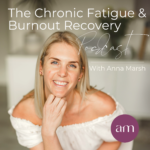
Shownotes
In this episode Anna explains how the nervous system works and how nervous system dysregulation can contribute to chronic fatigue and other health conditions. She offers an overview of how to begin to find more regulation day to day.
Useful links:
Website: https://annamarsh.co.uk/
Instagram: https://www.instagram.com/anna_marsh_nutrition/
Fatigue Recovery Quiz: https://app.annamarsh.co.uk/quiz
The Nervous System and Chronic Fatigue
Welcome back to the chronic fatigue and burnout recovery podcast. I will discuss the nervous system and chronic fatigue in this episode today. This is a really popular topic, and I think I always get asked on my Instagram stories on my Instagram account, how do I regulate the nervous system? I get lots of questions about the nervous system.
Over the past few years, as I’ve been recovering, more and more nervous system programs have popped up specifically for people with chronic fatigue and illness. So this episode today is to give you a little bit of an overview of the nervous system and why it is so important in chronic fatigue and fatigue recovery. Finally, I’ll just be talking about some things you can do to support your nervous system as you work on your fatigue recovery journey.
I’d like first to give an overview of how the nervous system is mapped out. This is something that I would normally teach my clients when we start working together when we’re doing nervous system-specific work because I think having the understanding and the awareness is helpful for people to understand what’s happening in their bodies. Usually, when people have chronic fatigue or chronic illness, especially where they feel a little bit abandoned, let down, or maybe even gaslighted by the medical system, there is this real need and want to understand, “What’s going on? What’s happening to me? What’s going on inside of my body?”
So I would like to do more of the, shall we call, head-based explanations. I want to talk a little bit about the important cognitive aspects that need and desire to understand. But I will also say that much of the nervous system’s work is not based on understanding. You don’t have to understand the ins and outs of how the nervous system works to have a resourceful nervous system. A lot of the magic of the nervous system work comes in practice and the self-regulating exercises, which I’ll touch on towards the end of the episode.
Starting with the nervous system breakdown, I was listening to a podcast the other day, and the person I won’t mention was the one whose podcast I was listening to keep on talking about the central nervous system. “This is your central nervous system going into a freed state.” It’s important to start and distinguish that we have the central nervous system, the brain, and the spinal column.
Then we have the peripheral nervous system, the branches that go out into the body. In that peripheral nervous system, we have more branches: the autonomic and somatic nervous systems. In today’s episode, I will discuss the peripheral nervous system, specifically the autonomic nervous system.
As we talk about this concept of nervous system regulation, we’re talking about the autonomic nervous system. Many people will be familiar with some of the initial stuff I’ll share, but some of you won’t, so it’s important to break it down and keep it simple. So the autonomic nervous system has two further branches.
We have this sympathetic nervous system, which is responsible for fight or flight, and I’m sure those terms will be quite familiar to most people. And then, we have the parasympathetic nervous system, which has two branches. We have the ventral vagal branch, which I call the soft break.
This is the segment of the parasympathetic system that is involved in self-regulation and co-regulation with other people and social engagement. When we’re looking at nervous system regulation, this is the part that we often want to strengthen and retrain. The parasympathetic nervous system also has the dorsal vagal complex, where the DVC.
The DVC is usually associated a little bit more with the sort of freeze response, the shutdown response, or the immobility response, that we can sometimes access if we become overstimulated with activation. Our sympathetic nervous system, the branch responsible for fight or flight, is often called the big spender. We use a lot of energy to activate our sympathetic nervous system, our fight-or-flight responses. I have been taught that the sympathetic nervous system is like a rocket ship.

It takes off fast and very quickly, and it activates everything all at once. This is when we’ll experience that increase in heart rate, that sudden constriction in our chest, maybe you’ll feel gripping in your stomach, the heart beating fast, breathing frequency increasing. There can be this flooding of intensity, very overwhelming intensity, when the sympathetic nervous system is very activated.
That second, the rocket ship shooting off into space requires a lot of energy to shoot off into space. But also, if we stay in that fight or flight response that’s very energetically demanding on the body, then we’ve got the parasympathetic nervous system, and the role of the parasympathetic nervous system is to counterbalance the sympathetic nervous system. In a well-regulated system that can use that ventral vagal complex, the soft break, we can tone down the parasympathetic responses and come into regulation.
But when somebody has lost what we call vagal tone, or that vagal brake isn’t finely tuned enough or strong enough because it just hasn’t been exercised or used enough, then we may rely more on the dorsal vagal complex, which is the heartbreak or the handbrake. How this has been taught to me is that the dorsal vagal complex is like a parachute coming over that rocket ship. If you can imagine a rocket ship shooting up into space, and then a parachute was coming over the nose of the rocket ship and then dragging the rocket ship back down to earth, yes, it’s counterbalancing the activation of the sympathetic nervous system.
But it takes a lot of energy to do that. We often think of the frozen state, immobility state, or shutdown state associated with this over-activation of the dorsal vagal complex as a very low energy state because we feel perhaps very fatigued or exhausted, or numb when we’re in a freeze. But a lot of energy is bound up in that free state.
One of the reasons people can stay stuck in freeze is that to come out of a frozen state would almost be like lifting that parachute. If we were to lift that parachute even a little bit, all the energy of the rocket ship could come rushing out. That could be very overwhelming for the body to experience all that sympathetic activation as the freeze state lifts.
Some people might stay stuck in trees because they haven’t built their capacity to tolerate the activation of the sympathetic nervous system. As the freeze starts to thaw, so here I’m going down a complete rabbit hole. But there’s so much nuance and complexity when working with the nervous system.
I want to keep this episode today as a basic general overview. But when working one-on-one with clients or in my group programs, we’ll get much more into the nuance and what’s going on with each individual’s specific nervous system and what they need. I wanted you to get from that rocket ship analogy that it takes a lot of energy to be in a fight or flight.
It also takes a lot of energy to be frozen because freeze holds on to all that sympathetic activation from fight or flight. When our energy is being prioritised to these survival responses for whatever reason, we don’t have energy that is just going towards prioritising the day-to-day function and maintenance of the body. And that’s the maintenance of your cells and your digestive tract and the maintenance of balanced hormones and balance, blood sugar, and all the different things we need to do.
There can be nutrient deficiencies daily because many nutrients affect our stress responses. Then we’re not absorbing nutrients very well from our food because digestion isn’t being prioritised. After all, we’re in a state of threat. So the result is this chronic wear and tear on the body.
If you’ve listened to some of my previous episodes, I talk a lot about this chronic wear and tear on the body, the cell danger response, and the consequences of being in this constant state of threat. Ultimately, these are adaptations that are life-saving in the short term. But when we get stuck in these survival adaptations for too long, they become destructive and dysfunctional.
This is where the nervous system starts to intersect with our ability to recover from these complex fatigue conditions and other chronic illnesses. So what I would say is that we often think of these survival states as being a bad thing, and there can sometimes be this message that we need to be very well regulated and very calm. There’s a lot of emphasis on calming the body down.
But actually, what we want to be able to do is to have the capacity each day to move through varied states. So to have flexibility between our ability to respond to something a little bit stressful and settle and return to baseline when things are safe. In a normal, healthy person, throughout the day, they’re probably moving through different states of activation. They’re probably quite relaxed, perhaps when they wake up in the morning.
But then, as the day continues, and there are emails, commuting, childcare, and all the different things that may come into one’s life throughout the day, one may feel more activated or very activated. But then they may take a lunch break or walk in the park for 30 minutes, maybe have a really lovely conversation with a friend, and that activation level comes down. In a healthy person, we should be moving through different states of activation throughout the day.
But when we get stuck in a state of activation, problems arise. Many people will become increasingly active throughout the day and then go a million miles an hour. They may be experiencing shallow breathing, and their heart is racing in their chest. They have a lot of muscle tension.
But they’re so busy and focused on the jobs they have to do all the things that need to get done. They’re not necessarily aware of their body and what’s going on. Therefore they don’t even notice how activated they are. Then it gets to the end of the day, and they wonder why they can’t get to sleep at night, wake up in the middle of the night, or their neck hurts. Why isn’t their digestion working so well?

Why do they feel so exhausted all the time? Why are they waking feeling unrefreshed? It’s because they’ve just been operating in this very, very high state of stress the whole day. Then the other thing that can happen is if the stress goes on too much for too long, or if anything happens that becomes too overwhelming for the body to cope with when we move through into fight or flight. But then we can also freeze.
The freeze usually happens when the activation level becomes so high that the body’s only way to cope or what the body perceives as the safest way to cope is to go into this freeze disassociation, shutdown, exhaustion, and immobility. It’s important to understand in this case that this is self-protective. The body isn’t, you know, trying to make your life difficult, or it’s not bad luck, or it’s not unfair.
Your body is always doing its very best to protect you and keep you safe, even when it’s not convenient to experience the consequences of that. We can sometimes move through fight or flight and get stuck in this very high sympathetic activation. Or we can get stuck in a free state so we can get stuck on, which is sympathetic activation, or we can get stuck off, which is that very extreme dorsal vagal activation.
What determines if we get it stuck on or off is the nervous system’s capacity. So we have what is known as the window of tolerance, which, as the name suggests, is the window in which a person’s nervous system tends to thrive. If the stresses we experience daily fall within our capacity within our window of tolerance, easy days, we can keep on flowing throughout the day.
But things like childhood trauma, big traumas that happened later in life, or lots of little traumas that happen across a lifetime, can all impact the window of tolerance. Even, you know, day to day, we can have changes in the window of tolerance. When we are at different places in our hormonal cycle, we may feel that our window of tolerance is narrower.
If you have a chronic fatigue condition, if you’re in a crash or flare, your tolerance window will be narrower. If you haven’t had a good night’s sleep, your tolerance window will be narrower. If you haven’t eaten very well, if your blood sugar has gone too low or too high, perhaps you will have a narrow tolerance window.
We can have big things that happen in life which are out of our control, which impact the window of tolerance. Then we can also have things in our day-to-day life that are within our control to a certain degree that impact the window of tolerance. But either way, if we had lots of childhood trauma, if we had lots of chronic stress throughout our life, if we had some big, you know, things happen like a divorce or operations or an accident or some financial issues, or we made redundant from a job, you know, various things can happen, we may experience a narrowing of the window of tolerance over time.
What this means is that we tolerate less, quite literally, but the small things become big things. And it’s easier and easier for the body to become overwhelmed, and we spend more time in that fight or flight energy system, we spend more time perhaps even going into freeze, and then it’s easier to get stuck.
Because there’s a loss of regulation, there’s a loss of capacity to cope. So circling back to that ventral vagus nerve, when we are constantly in this high state of activation, we lose vagal tone because we’re not spending enough time using that part of our nervous system. That’s also what results in a narrowing of the window of tolerance.
One way we expand our tolerance window is by increasing vagal tone, which means using that ventral vagal branch of the nervous system more intentionally daily. I like working out in the gym, and I’ve been a fitness person for almost all my life. I used to love going to the gym before becoming unwell.
And now that I am well enough to do so, I’m enjoying going back to the gym and lifting weights. When someone lifts weights, we know that they have to exercise the muscle to get stronger and more effective and grow. The same goes for your ventral vagal complex; we must exercise that part of our nervous system.
Because if we don’t use it, we lose it. So when we let the day take control, get up in the morning, and just go 100 miles per hour, and there’s no settling that happens naturally throughout the day, we’re not using the ventral vagal complex. One of the first things I say to my clients is just starting to take little breaks, where you maybe do something for a couple of hours, and then you take a little pause, you allow your system to settle, and then you go again.
I had a client, a super busy client, and she was working for the NHS. She had fibromyalgia. She was so busy, with loads of meetings, always too much to do, and not enough resources in the day. But she said I can commit to doing one minute of breathing every hour. All she did was slow down her breath every hour.
She just set a little alarm, a little reminder on her phone, and she did so across an eight-hour workday of eight minutes of breathing spread out across the day. And the difference that it made was phenomenal. She just felt so much more balanced.
So much more grounded and less exhausted by the end of the day because she was doing eight exercises for her ventral vagal complex across the day. If you want a little tip, that’s a little hack that you can do. There’s so much I could say here, but what I’m going to transition into, what we can do or what else we can do to begin to achieve more regulation in the system.
Here, I’ll say, especially if you go online, a lot of people are saying, “Do this exercise, this will be good for your vagus nerve, or do that exercise, and this will be good for your vagus nerve.” I don’t doubt that those exercises are helpful. But I have a slightly different process that I’d like to introduce to you too.
Those exercises might be part of the process. But I want you to understand the bigger picture. How do we achieve more or better self-regulation? The very first step is to slow down the pace of your life. I explained to my client with fibromyalgia how she felt like she couldn’t slow down the pace of her life.
But she could take those single minutes, once every hour, to create a little bit of slowness, making a difference. But one of the first stages of change is awareness. To become aware of anything, we have to have a little space, and we have to create a little space for that awareness.
And actually, one of the things I love about working with fatigue clients is that by the time they come and see me, most of them have got that spaciousness because their body has given it to them. They aren’t able to have a very busy life because their body just won’t let them. So fatigue recovery is an excellent opportunity to have this space to slow down. Still, even I remember, in the early days of my fatigue recovery, I was so uncomfortable with slowing down that even though I was maybe lying down “resting.”

I was busy, and I was on social media, I was listening to podcasts, I was reading books, and I was filling my brain with more information and more information. That was just completely overloading my system even more. We want to slow down and start to become aware. That’s the first step. What’s going on?
The second step is awareness and attunement. Once we have that space, whether it’s that one minute in between meetings, or if it’s, you know, just putting away the social media, putting away the books, putting away the podcasts, and just allowing yourself to be with your body a little bit, then you can start to become aware of “What is here with me now? What’s happening in my body?
This is what I refer to as attunement. So attunement is to harmonise, and it’s really to connect with the body, the sensations that are present, and to give the body what it needs. This is where one of the techniques I teach my clients is just tracking, tracking the sensations in the body.
It’s very common in chronic illness for the body to be a very uncomfortable place to be. Therefore we tend not to want to feel the body, and if you’re having problems feeling and experiencing your body because it feels very unsafe to do so, there are other techniques you can use. That’s maybe a different episode for another day. But we tend to also focus on what doesn’t feel good because we have this dangerous bias.
We’re constantly scanning for danger and threats in our environments. We’re going to notice all “My head feels achy, and my shoulders feel achy, and this much tiredness behind my eyes.” But I would also invite you to begin to look for what feels okay.
Does it feel neutral, at least if it doesn’t feel good? Even if it’s just your baby toe, ear lobes, or cheeks? Start to look for the places in your body that might have some positive sensations, but if not, maybe just some neutral sensations and start to become aware of what’s happening. Because once we start to become aware of what’s going on in the body, we can then start to become aware of what we need, and so many people with chronic illness and fatigue have pushed past the needs of their body time and time and time again.
Part of healing is coming back into attunement with the body’s needs. This brings me to my next step, step three, which is giving the body what it needs, or what I also like to refer to as resourcing. We want to create resourcefulness in your system. And resourcefulness is a counter force to the dysregulation of the nervous system to the dysregulation created by trauma that hasn’t yet been integrated into the body. We want to build up resources, and not just exercises that you do, but we want you to build a resourceful life.
Here, I like to frame this as your nervous system interacting with the food you eat, the environment that you’re in, the people that you spend time with, the animals that you spend time with what you’re doing, you know, your social media work, reading books, or cooking or gardening, whatever it might be, your nervous system is interacting with everything, every single moment of every single day. You want to take that time now that you’ve slowed down and you’ve attuned to ask yourself, “Is the way I’m spending my day today resourcing my nervous system? Or is it depleting my nervous system?” This doesn’t mean that absolutely everything we do needs to be resourced – not at all.
But maybe while you are healing, there need to be more things that are resourcing and fewer things that are depleting. Then you start to create a life and an environment that supports the resourcefulness of your nervous system. Because it’s all very well knowing that for six breathing, for example, breathing in for four out of six, helps to calm down the nervous system.
But if you do you for six, breathing for 10 minutes, and you walk back into a job that you hate, into a relationship that you hate, or you’re spending time with people that make you feel bad, or you’re eating terrible food. You’re not getting outside, and you’re not doing anything that you love. You’re not going to get the impact you want in changing the nervous system, so we want to build resourcefulness. The other reason we want to build resourcefulness is that resourcefulness supports the capacity of the nervous system. It widens the window of tolerance. And when the nervous system is more grounded, more supported, more resourceful, then we can start to go into some of the other stuff we may want to look at if you feel that there’s past trauma that you want to look at or investigate, or you maybe need to do some brain retraining or things like that, you’ve already built some capacity within your nervous system.
That takes me to the next thing we may want to consider. So brain retraining is popular. If you’ve done any research around fatigue recovery, you’ve probably already heard of it. I guess different people will have different takes on the brain retraining, but it’s using your thoughts and your mind to change the signals sent to the body.
So brain retraining is like a top-down approach. That means that we are maybe looking at certain ways of thinking or certain belief systems that are causing stress to our bodies because we think about things in a stressful way, or we believe something about the world which makes the world a stressful place to live in. Part of brain retraining is becoming aware of and then reconditioning these thought or belief patterns, which influence our behaviour.
In doing so, we know we can change the body’s response to our thoughts internally, but maybe also change external behaviours that keep us stuck in our fatigue. The thing to remember about brain retraining is it is top-down. Most communication happening in the nervous system is from the body to the brain, so it’s from the bottom up.
So I trained in NLP – Neuro Linguistic Programming, a huge foundation of brain retraining, about 14 years ago, and I’ve done my coaching qualifications. I’ve done neuro strategy qualifications. I’ve worked a lot with what I would call this “mindset work” in the past with my clients.
Since diving more into the somatic world, which I’ll talk about in a second, I find that the best way to use brain retraining is if we can integrate it with the body’s somatically because there is a saying that our state defines our stories, or stories follow state, which means that our state, the state of our nervous system, how activated the nervous system is, will determine how we then think, how we then believe, therefore what we do or what behaviours we create as a consequence. So if we use affirmations, for example, if you feel unsafe in your body, and then you use an affirmation, “I am safe, I am safe, I am safe.” But your body is sending you a very different signal.
Sometimes that can heighten the activation within the body because the body doesn’t feel like it’s being attuned. We want to use some mindset tools. But we want to integrate that with a body receptive to receiving those tools.

Again, you know, that’s a whole thing that I teach in my high achiever revival program and with my one-on-one clients, so it’s way beyond the scope of today’s episode to go into that in much more detail. But just to say that brain retraining is best combined with somatic work so that we can get to land in the body. The next thing that you may want to do to support your nervous system is maybe some somatic work.
Here, it might be important to distinguish between Cymatics and somatic experiencing. Cymatics is any kind of mind and body-based practice where we use interception. Interception is our ability to sense within the body and to be able to sense what’s going on inside the body.
Interception and somatic practices work because we bring our mind or cognitive attention to the body. Doing that has a very settling effect on the nervous system and helps the nervous system to settle. That’s one of the ways that we can strengthen the vagal brake.
There are various somatic practices out there, some of them may involve sounds or movements, and there’s a wide variety of things that you can do somatically to support your nervous system. Then we have somatic experiencing, a very specific practice requiring a lot of training. The purpose of somatic experiencing is to safely release and integrate shock and trauma and survival energies that are stuck in the body due to traumas that have been experienced, either big traumas or little traumas, and chronic stress.
It can be helpful to have individuals process the survival energy relating to specific events. It can also help the individual tolerate stress and widen the tolerance window. There’s a lot of similarity and overlap between the two.
But I would say the difference between Cymatics and somatic experiencing is that somatic experiencing is much more specific to the needs of the individual. For example, some somatic practices may be to discharge the energy of anger, which might encourage someone to push against a wall, hit the pillow, scream into a pillow, or make a sound. But Somatic experiencing would work with the person’s nervous system and understand how that person’s nervous system wants to integrate that survival energy.
For example, when someone senses something in their body, they bring up a specific event or something they may feel angry about. They may not want to push or punch or scream. Maybe there’s another movement or sound that the body wants to make. For this reason, a much higher level of integration and resolution can be achieved through somatic experiences.
And somatic practices, when inappropriately attuned, can raise the system’s survival energy. Suppose someone hasn’t built the capacity to tolerate anger and is invited to discharge by pushing a wall or screaming into a pillow. In that case, that can raise that level of fight energy in the body, which may be too much for them to handle. This is why we always want to start from the ground up by slowing down awareness and attunement, building resourcefulness, and then going into some of these more sophisticated practices.
The final thing on my list regarding nervous system regulation is hormetic stressors. Hormetic stressors create a small inflammatory effect in the brain, which then causes an anti-inflammatory impact on the rest of the body. This can be very beneficial for the nervous system.
This is where we can use heat stress, cold stress, fasting, exercise, hypoxia, and low oxygen states to stress the body and challenge the nervous system to build its capacity to handle stress. This usually comes much later in someone’s journey for reasons already discussed. We want to have a good level of attunement, and we want to have a good level of resourcefulness and resilience in the body.
First and foremost, before we start adding these big external stressors, it’s very easy to do too much, especially when someone’s not well attuned to their body and their capacity and tolerance. These hormetic stressors are dose-dependent. So that means that how much is appropriate for one person may be different for another.
Again, it’s beyond the scope of this episode to go into detail about the ins and outs of all these hormetic stressors. That’s something I’ll do in another episode in the future. But for now, just understanding that these are something that can positively influence the nervous system when used in the appropriate dosage and at the right point in someone’s fatigue recovery journey, you wouldn’t be adding in hormetic stressors when somebody is still very dysregulated, or still in a state of cell danger response one, for example, when there’s a lot of threat already still going on in the body.
These things will come later as we expand the person’s capacity. I didn’t have this on my list, but it’s worth mentioning that we also achieve nervous system regulation by supporting the body’s physiological processes. Blood sugar, which I will talk about in the next episode, is important for nervous system regulation, good digestive health, eating an anti-inflammatory diet, and having adequate nutrients. These are all going to be really important things for the nervous system.
Because if we have dysregulated blood sugar and dysbiosis in the gut, if we lack nutrients, that’s stressful for the body. Some are messaging you may come across as you go through your fatigue recovery journey, as all we need is nervous system regulation to become well. I beg to differ.
I believe nervous system regulation is a really important part of the puzzle. But we have to think about the big picture and how we are supporting the body from all angles because these physiological and biochemical imbalances can just regulate the nervous system. I want to make sure that we are seeing and addressing those.
That brings me to the end of this episode today. There was so much I feel I could have said here. I felt like I missed out so much, and I hope I have done the episode some justice, at least. If there are any other questions or things you feel you’d like to know more about, please feel free to reach out to me through social media or my website, and then I can pick up on those things in a future episode. Until then, may you have a wonderful fatigue recovery day.








